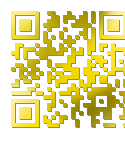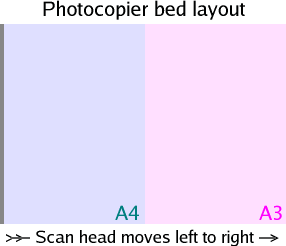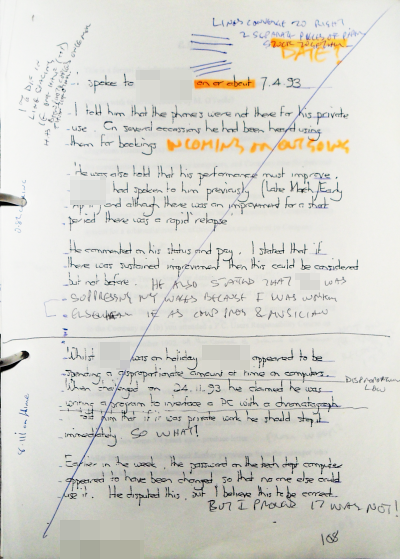
 |
|
| Mobile-sized | ||
| This site: | ||
| Home | ||
| Copyright | ||
| Let the Devil Wear Black: | ||
| Briefly. | ||
| ||
| Additional Resources... | ||
| James Linden: | ||
| Background | ||
| Contact | ||
Resources - Forensic photocopier
Photocopying is not quite what it seems.
Chapter 10
Here is the photocopied sheet that had somehow managed to be photocopied a different number of times — depending upon where on the sheet anything was.
As with all of these documents, it has been through the process of being used and as a result, it is covered with scrawl. You can see across the top the comments about the fact that the lines converge to the right and you can see down the left hand side the comments about the pitch being different for the top and the bottom of the page.
Virtually every photocopier you will encounter in business today, as well as libraries and other places, has a DIN A3 bed so that it can produce photocopies of A3 paper as well as A4.
So as to make the workings of the machine plausible but primarily to keep costs down, the scanner scans along the length of the page with the reading head as long as the width so the head is around a foot long and moves around 1.4 feet in keeping with the size of A3 paper.
When copying DIN A4 paper, the paper is laid across the bed so that the A4 sheet's longest side matches the A3 bed's shortest side and it is scanned sideways.
As a result of this, a sheet of lined paper will keep its parallel lines and they will not converge to either side.
One potential source of changed spacing between lines is tracking-rate errors in the scanning in the photocopier if you scan the page on its side, for some reason, although this would not make the lines converge to one side either.
On older machines, the scanning used to be done by setting the motors to run at a particular speed so that it scanned the document at a given speed and printed onto the drum at the same speed — for same-scale reproductions or a factor of that for zooming in or out.
If there was wear-and-tear in the system, you might have areas there the speeds didn't match and you could end up with a variable horizontal scale across the page. One indicator of that problem is the colour of the paper — the very light grey that the paper produces — would vary as stripes of lighter and darker grey as the speed-mismatch manifested itself.
This would also show up in the edges of characters and other areas of print where over-printing would shift the border between black and white, making letters, in particular, become bolder or lighter as the mismatch manifested itself.
However, this problem was removed by the use of digital motors and tracking systems that make sure that the scanning rates match so that problem would not arise in this instance.
Further, from the fact that the paper is scanned from left to right — or even if it was scanned from right to left — the vertical spacings between the lines are preserved therefore scanning speed does not enter into the measurements.
Finally, by default, photocopiers will blow up an image by one per cent so as to make it look more impressive without being noticed on a conscious level.
I have never met another user of photocopiers that has been aware of this fact.
Thus, each time you photocopy a piece of paper, the image on it grows by one per cent unless you take positive action to stop it from doing so.
To correct it, increase the zoom by one per cent by pressing the zoom increment button once and it should say '102%'.
Then, decrease the zoom by two per cent by pressing the zoom decrement button twice and it should now say '100%'.
If instead, you only pressed the decrement button once, it would take it straight to '99%' instead.
To the normal user a one per cent increase makes it look better but to the unsuspecting fraudster, it is a trap.
So, objectively:
Subjectively:
- In the case of this piece of paper, the lines of the top half and the bottom half converge to the right by a whole millimetre, inconsistent with it being a single document but which is entirely consistent with it being a composite of two documents that were not very well aligned on the photocopier bed;
- In the case of this piece of paper, the lines on the top half of the paper had a spacing of 8.2mm whereas the lines on the bottom half of the paper had a spacing of 8.11mm, a difference of around one percent which is well outside experimental error thus indicating that the top half had been photocopied one more time than the bottom half. This is inconsistent with it being a single document but entirely consistent with it being a composite of two documents originating from a common paper stock — the top document of the composite having been photocopied one more time than the bottom document; and,
- There is no toner shade banding — either vertically or horizontally. This is inconsistent with any problems with motor speed or tracking in the copying process, but it is entirely consistent with it being a composite of two documents which had different line spacings.
Therefore, on the balance of probabilities, it is likely that this document is a false instrument.
- Recollection of first sight of this document in the appeal hearing is that it had only the top half — the bottom half was not on this document at that time;
- The gap in between the two halves of the document is suspiciously large and is entirely inconsistent with the rest of the document. There is enough space in between the two halves of the document for another, two line paragraph or an additional nearly three lines of the preceding paragraph.
- The subject matters of the two halves are different suggesting two documents;
- Each of the two document halves go into an alleged event in a fair amount of detail without any similar events at any other events being mentioned and,
- The dates mentioned in each of the two halves 7th April 1993 and 24th November 1993 are so far apart that it is unlikely that they would appear in a single document that went into this level of detail.
“I’ve got a tape recorder with me.” - “Can it record without being seen?”



